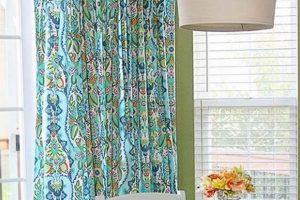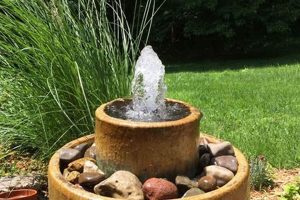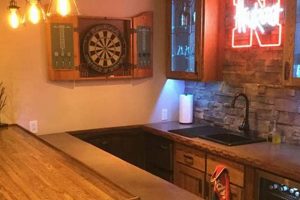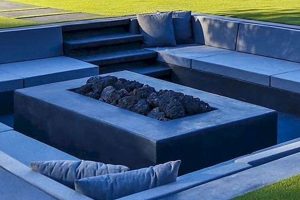Creating a “do it yourself” ensemble inspired by the titular character from the film Beetlejuice involves designing and constructing a costume at home rather than purchasing a pre-made version. This process typically requires resourcefulness in sourcing materials and employing crafting techniques to replicate the character’s signature striped suit, wild hair, and ghoulish makeup.
Embarking on a homemade version of this iconic outfit offers significant advantages. It allows for complete personalization, ensuring a unique and well-fitting garment. Furthermore, it often proves to be a more economical solution compared to purchasing a professionally manufactured costume. The film’s enduring popularity, coupled with the easily recognizable nature of the character’s aesthetic, contributes to the sustained interest in crafting this type of attire for Halloween and costume parties.
The following sections will provide detailed guidance on achieving key elements of the character’s appearance, including replicating the striped suit, styling the distinctive hair, and applying the signature makeup, thereby facilitating the creation of a successful interpretation of the characters look.
Crafting a Convincing Look
Achieving a recognizable likeness requires careful attention to detail. The following tips provide guidance on how to effectively create components.
Tip 1: Suit Construction. Utilize readily available materials such as thrift store finds. A pinstripe suit, even if not perfectly aligned with the character’s design, can serve as a strong foundation. Alterations, including adding or modifying stripes with fabric paint or tape, can enhance accuracy.
Tip 2: Makeup Application. The character’s decaying appearance is critical. Employ layering techniques, starting with a pale base and building up contouring with shades of green, brown, and gray. Explore readily available tutorials for guidance on achieving a realistic and unsettling aesthetic.
Tip 3: Hair Styling. Wild, unkempt hair is essential. A wig, styled with hairspray and teased to achieve volume, provides a controlled and customizable approach. Alternatively, individuals with sufficient natural hair can use styling products to emulate the disheveled look.
Tip 4: Accessorizing. Attention to supplementary elements adds depth. Consider incorporating accessories such as decaying teeth (achieved through dental wax or special effects makeup) or faux insect embellishments to enhance the overall presentation.
Tip 5: Fabric Selection. Opt for fabrics that mimic the texture and weight of a classic suit. Broadcloth, twill, or even repurposed heavier curtain material can provide a sturdy base for adding stripes and creating the overall suit silhouette. Consider the season when selecting fabric to ensure comfort while wearing the costume.
Tip 6: Achieving Stripes. Precision is key to replicating the iconic striped pattern. Painter’s tape is an effective tool for creating clean, even lines when using fabric paint. Ensure the base fabric is taut and wrinkle-free before applying the tape for optimal results.
Tip 7: Aging and Weathering. To capture the character’s undead nature, introduce weathering effects. Strategic application of diluted brown or black paint can simulate dirt and grime, contributing to a more authentic and unsettling appearance.
Attention to these factors will improve the final presentation, contributing to a memorable and recognizable portrayal.
By applying these principles, individuals can realize a convincing and effective interpretation.
1. Striped Suit Replication
Striped suit replication constitutes a fundamental element in creating a successful “do it yourself” ensemble. Its accuracy significantly impacts the overall recognizability of the costume. The cause-and-effect relationship is direct: a poorly replicated suit detracts from the portrayal, while a well-executed version enhances the character’s distinctive visual impact. For instance, inaccurate stripe width or color diminishes the effect, while faithful reproduction contributes to a convincing likeness.
The significance of precise replication lies in the suit’s iconic status within the film. It is arguably the most recognizable feature, and deviations from the established design are readily apparent. Creating the suit at home might involve adapting an existing garment or crafting one from scratch. A practical example is using painter’s tape to mask off stripes on a plain black suit, or sewing stripes onto a white suit. The level of detail and accuracy invested in this component directly correlates with the costume’s overall effectiveness.
In conclusion, replicating the striped suit stands as a critical challenge in crafting a successful portrayal. Overcoming challenges related to fabric, stripe pattern, and construction yields a finished product that is instantly recognizable and impactful. The suit’s importance cannot be overstated, as it provides the foundation upon which the entire costume is built.
2. Makeup Palette Selection
Makeup palette selection is a critical determinant in the successful execution of a “do it yourself” Beetlejuice costume. The character’s distinctive, ghoulish appearance relies heavily on specific color choices and application techniques. The chosen palette directly influences the verisimilitude of the homemade costume.
- Base Tone Attainment
Achieving the appropriate base tone is paramount. A pale, almost sickly white or grayish hue is necessary to replicate the character’s undead complexion. The selection of a foundation that lacks warmth is crucial; options may include stage makeup or specialized pale foundations designed for theatrical use. Failure to acquire a sufficiently pale base undermines the overall effect.
- Contouring and Shadowing
Contouring and shadowing colors define the character’s gaunt features and accentuate the impression of decay. Shades of grey, green, and brown are typically incorporated to create sunken cheeks, hollow eye sockets, and prominent bone structure. The application of these colors requires careful blending to avoid harsh lines and achieve a realistic, unsettling look. The strategic use of darker shades enhances the illusion of emaciation.
- Lip and Eye Detailing
Lip and eye detailing further contributes to the overall effect. The lips are often rendered in muted tones, such as grey or dark purple, to simulate lifelessness. Dark eyeshadow or liner is used to emphasize the eyes and create a haunting gaze. The application of these details must be precise to avoid a cartoonish or unrealistic appearance. The selected colors should complement the base tone and contouring shades.
- Sealing and Setting
The selection of sealing and setting products ensures the longevity and durability of the makeup application. A translucent setting powder is used to prevent creasing and smudging, while a setting spray helps to meld the various layers of makeup and create a cohesive finish. The use of high-quality setting products is particularly important for extended wear, as it prevents the makeup from fading or transferring.
In conclusion, strategic makeup palette selection and skillful application are indispensable for a believable “do it yourself” Beetlejuice costume. The correct blend of colors, coupled with attention to detail, elevates the homemade costume from a simple imitation to a convincing portrayal of the character. The investment in quality makeup products and the mastery of application techniques are essential for achieving a truly impactful result.
3. Hair Volume Creation
Hair volume creation constitutes a pivotal aspect of realizing a convincing “do it yourself” Beetlejuice costume. The character’s disheveled and voluminous hairstyle is immediately recognizable and contributes significantly to the overall aesthetic. Achieving this look at home necessitates careful planning and execution.
- Wig Selection and Modification
Selecting an appropriate wig is often the most practical approach. A wig with ample initial volume, preferably synthetic for ease of styling, provides a strong base. Modification techniques include teasing the fibers, backcombing, and applying hairspray liberally to maintain the desired shape. The wig’s color should closely match the character’s unkempt green-tinged hair, often achieved through spray-on color or strategic dyeing. A poorly chosen or ill-prepared wig detracts significantly from the overall costume.
- Natural Hair Styling Techniques
Individuals with sufficient natural hair length and thickness may opt to style their own hair. This approach requires extensive teasing, backcombing, and product application. Hairspray, mousse, and styling gels are essential to achieving the necessary volume and texture. The process can be time-consuming and may require multiple attempts to achieve the desired effect. Furthermore, this method carries the potential for hair damage if not executed carefully.
- Volume Enhancement Accessories
Various accessories can aid in volume creation. Hair padding, such as foam inserts or mesh forms, can be strategically placed beneath the hair or wig to provide additional lift. These accessories are particularly useful for individuals with thinner hair or for achieving extreme volume. The selection of appropriate padding material is crucial to ensure a natural and seamless appearance. Improper placement or mismatched colors can result in an unnatural or comical look.
- Maintaining Style Integrity
Maintaining the hairstyle’s integrity throughout wear is a significant challenge. The voluminous style is susceptible to collapsing under its own weight or due to external factors such as wind or movement. Regular application of hairspray and strategic pinning can help to preserve the style. Furthermore, careful handling of the costume is essential to prevent damage to the hairstyle. A collapsed or disheveled hairstyle detracts from the overall impact of the costume and diminishes the character’s recognizable features.
The aforementioned factors are essential considerations in realizing an effective portrayal. Effective hair volume creation directly impacts the recognizability and impact of a ‘do it yourself’ effort. Careful execution contributes significantly to the authenticity of the overall presentation.
4. Weathering and Aging
The application of weathering and aging techniques is crucial for realizing a successful “do it yourself” Beetlejuice costume. These effects transform a newly constructed or acquired garment into a representation of the character’s decayed and otherworldly appearance, contributing significantly to the overall believability and visual impact.
- Fabric Degradation Simulation
Simulating fabric degradation through controlled damage and staining enhances the costume’s authenticity. Techniques include strategically placed rips and tears, achieved through careful cutting or abrasion with sandpaper. Diluted brown or black paint, applied in layers, creates the appearance of dirt and grime accumulation. The extent and placement of these effects should reflect the character’s prolonged exposure to the afterlife. Excessive or haphazard application can detract from the costume’s overall impact.
- Color Fading and Discoloration
Fading and discoloration simulate the effects of time and decay on the costume’s materials. Achieving this effect involves selectively bleaching or sanding certain areas to lighten the fabric’s original color. Applying diluted dyes or fabric paints in muted tones, such as grey or brown, creates subtle discoloration patterns. The goal is to replicate the uneven fading and staining that would naturally occur over time. Overdoing this effect can result in an unnatural or cartoonish appearance.
- Textural Alterations
Altering the fabric’s texture enhances the illusion of age and wear. Techniques include stiffening portions of the fabric with diluted glue or fabric stiffener to simulate the effects of dried dirt or bodily fluids. Applying a fine layer of sand or dirt to the fabric and then sealing it with hairspray or fabric sealant creates a textured surface. The application of these effects should be subtle and strategic to avoid compromising the costume’s integrity or comfort. Excessive or uneven application can create an unappealing or distracting texture.
- Makeup Integration
Integrating makeup with the weathering and aging of the costume creates a cohesive and believable appearance. Applying makeup to exposed areas of skin that are visible through rips or tears in the fabric reinforces the character’s decayed state. Matching the color palette of the makeup to the overall color scheme of the costume creates a unified aesthetic. The integration of makeup and costume weathering should be seamless and subtle to avoid a jarring or disjointed appearance.
Implementing weathering and aging techniques significantly elevates the impact of a homemade costume. This, alongside makeup integration and strategic degradation, creates an authentic, instantly recognizable costume.
5. Accessorizing Details
Accessorizing details constitutes a crucial yet often underestimated component within the realm of crafting a “do it yourself” ensemble. Their inclusion amplifies the costume’s authenticity, transforming a mere approximation into a recognizable portrayal. The absence of carefully selected accessories weakens the overall impression, diminishing the costume’s ability to effectively communicate its intended character. For instance, the inclusion of decaying teeth, achieved through dental wax or specialized makeup, elevates the character’s ghoulishness, whereas their absence renders the look less impactful. The correlati
on between thoughtful accessory selection and a successful “do it yourself” costume is demonstrably strong.
Practical applications of this understanding are varied. The incorporation of faux insect embellishments, strategically placed on the suit or makeup, enhances the unsettling nature of the portrayal. Similarly, creating decaying fingernails using acrylics and specialized paint techniques adds a layer of detail often overlooked. The sourcing of authentic-looking props, such as a handbook for the recently deceased (fabricated or acquired), bolsters the narrative element of the costume. Attention to these supplementary aspects reveals a dedication to accuracy, resulting in a more immersive and believable character representation.
In summary, accessorizing details serves as a pivotal element in the creation of a successful portrayal. The selection and execution of these elements present challenges, requiring resourcefulness and attention to detail. However, the commitment to these details elevates a homemade garment from a basic attempt to a convincing and memorable likeness. Furthermore, the dedication to accessorizing exemplifies thoroughness in pursuit of an effective costume, reflecting a strong understanding of design principles.
Frequently Asked Questions
This section addresses common inquiries and concerns encountered when constructing a homemade version of the characters costume, providing insights into optimal techniques and material selection.
Question 1: What is the best method for replicating the character’s striped suit at home without advanced sewing skills?
Answer: Modifying an existing pinstripe suit, acquired from a thrift store or online marketplace, offers a practical solution. Fabric paint or adhesive fabric strips can be employed to adjust the stripe pattern and color to match the character’s iconic attire. Precise measurements and careful application are essential to achieve a convincing result.
Question 2: What makeup products are essential for achieving a realistic “undead” complexion?
Answer: A pale foundation, several shades lighter than the wearer’s natural skin tone, serves as a base. Contouring with shades of grey, green, and brown creates sunken features and simulates decay. Setting powder and spray ensure longevity and prevent smudging. Experimentation with layering and blending is encouraged to achieve a desired effect.
Question 3: How can appropriate hair volume be achieved for the character’s hairstyle if natural hair is insufficient?
Answer: A wig provides the most reliable means of replicating the character’s voluminous hairstyle. Teasing, backcombing, and hairspray application enhances the wig’s volume and texture. Alternatively, hair extensions or padding can be integrated with natural hair to create the illusion of greater fullness.
Question 4: What are effective techniques for weathering and aging the costume to reflect the character’s decaying state?
Answer: Strategic application of diluted brown or black paint simulates dirt and grime accumulation. Ripping or tearing the fabric in select areas creates the appearance of damage. Sandpaper or a wire brush can be employed to distress the fabric’s surface. Moderation and restraint are crucial to prevent overdoing weathering effects.
Question 5: What are some easily obtainable accessories that enhance the overall authenticity of the costume?
Answer: Decaying teeth, achieved through dental wax or specialized makeup, add a touch of ghoulish realism. Faux insect embellishments, affixed to the suit or makeup, contribute to the unsettling aesthetic. A replica of the “Handbook for the Recently Deceased” serves as a recognizable prop.
Question 6: What precautions should be taken when applying makeup and styling hair to ensure comfort and prevent skin or hair damage?
Answer: Perform a patch test with makeup products to identify potential allergic reactions. Use high-quality, non-toxic makeup designed for theatrical use. Apply a barrier cream to protect the skin from harsh chemicals. Avoid excessive teasing or backcombing of natural hair to prevent breakage. Remove makeup and hair products thoroughly after wear.
Careful consideration of the advice in this section improves the final product, ensuring that the costume becomes instantly recognizable.
The concluding section will summarize critical points and offer final recommendations.
Conclusion
This exploration of “diy beetlejuice costume ideas” has illuminated the multifaceted nature of recreating the iconic look. Achieving a convincing portrayal necessitates careful attention to several key areas: the striped suit replication, makeup palette selection, hair volume creation, weathering and aging techniques, and accessorizing details. Each element contributes significantly to the overall impact, requiring resourcefulness, skillful execution, and a commitment to accuracy.
The successful execution of homemade versions, therefore, represents a convergence of creativity, craftsmanship, and a deep appreciation for the source material. While challenges inevitably arise during the construction process, diligent planning and meticulous execution can yield a final product that transcends mere imitation, becoming a testament to the transformative power of “do it yourself” artistry. Further exploration of advanced techniques and material sourcing will undoubtedly contribute to future refinements in “diy beetlejuice costume ideas,” pushing the boundaries of what can be achieved through individual creativity and skill.







